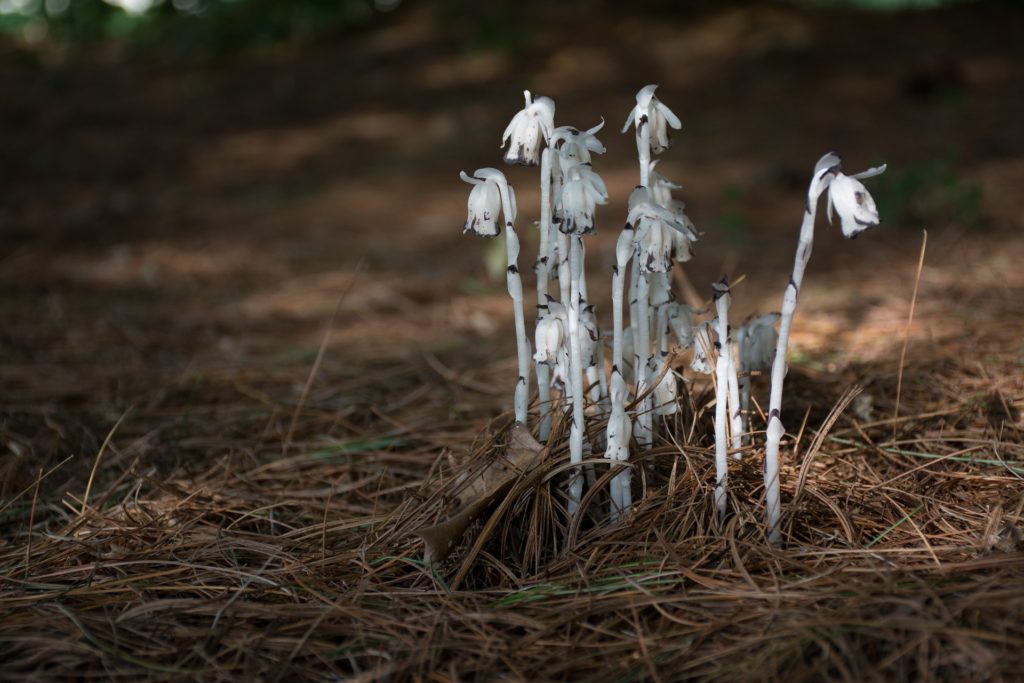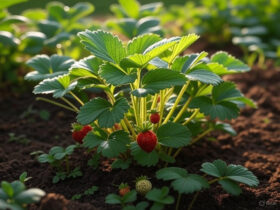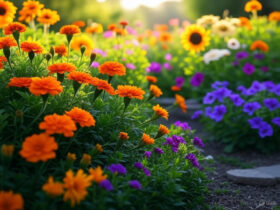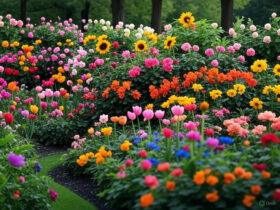Many flowers need sunlight to bloom. But some flowers thrive in darkness.
Have you ever wondered which flowers can grow without sunlight? These unique plants have adapted to survive in low-light environments. They bring beauty to places where other flowers cannot. This fascinating ability makes them special and intriguing. Imagine having a garden that glows at night with these rare blooms.
Discovering these flowers can change the way you think about gardening. Join us as we explore these amazing plants and learn how they flourish in the dark.
Types Of Night-blooming Flowers
Flowers that bloom at night are fascinating. They add mystery and beauty to any garden. These flowers wait until the sun sets to show their full splendor. Below, we explore different types of night-blooming flowers. These include Moonflowers, Evening Primrose, and Night-Blooming Jasmine. Each type has unique qualities that make them special.
Moonflowers
Moonflowers are a type of flower that grows in the dark. They open up at night and close when the sun rises. These flowers are white and have a sweet fragrance. They are perfect for flower plants that grow in the shade.
Here are some key points about Moonflowers:
- Scientific Name: Ipomoea alba
- Bloom Time: Night
- Color: White
- Fragrance: Sweet
Moonflowers can be grown easily. They need well-drained soil and a sunny spot during the day. At night, they thrive in the shade. They can climb trellises, making them great for adding height to your garden.
Moonflowers are also low-maintenance. They do not need much water. Just ensure the soil stays moist. These flowers are perfect if you want a flower that grows in the dark and requires little effort.
Table of Contents
Evening Primrose
Evening Primrose is another beautiful flower that blooms at night. It is known for its yellow petals. This flower opens in the evening and stays open until mid-morning. It is a great choice for flower shrubs that grow in shade.
Important details about Evening Primrose:
- Scientific Name: Oenothera biennis
- Bloom Time: Evening to Morning
- Color: Yellow
- Fragrance: Mild
Evening Primrose can grow in poor soil conditions. It is also drought-tolerant. This makes it a hardy choice for any garden. It can grow up to five feet tall. This makes it ideal for adding structure to your garden.
To grow Evening Primrose, plant the seeds in spring. Water them regularly until they are established. After that, they need minimal care. This makes them perfect for busy gardeners.
Night-blooming Jasmine
Night-Blooming Jasmine is famous for its strong fragrance. This flower blooms in the dark and can fill your garden with a sweet scent. It is an excellent choice for flower shrubs that grow in the shade.
Details about Night-Blooming Jasmine:
- Scientific Name: Cestrum nocturnum
- Bloom Time: Night
- Color: Greenish-White
- Fragrance: Strong and Sweet
Night-Blooming Jasmine can grow up to 13 feet tall. It prefers well-drained soil and a spot that gets some shade during the day. This flower is also a great choice for attracting pollinators like moths.
To grow Night-Blooming Jasmine, plant it in spring or fall. Water it regularly until it is established. After that, it needs minimal care. This makes it a low-maintenance option for any garden.
In summary, Moonflowers, Evening Primrose, and Night-Blooming Jasmine are all excellent choices for adding beauty to your garden at night. They are easy to grow and require little maintenance. They are perfect if you want a flower that grows in the dark and adds a touch of mystery to your garden.

Credit: www.chattnaturecenter.org

Adaptations To Darkness
In the mysterious world of plants, there exists a fascinating phenomenon: flowers that grow in the dark. These plants possess unique adaptations to thrive without the sun’s direct rays. While most plants bask under bright sunlight, some flower plants that grow in the shade have evolved to make the most of their dim environments. This adaptability not only allows them to survive but also to flourish in shadowy realms where light is scarce. From photosynthesis at night to specialized pollination strategies, these plants offer intriguing insights into nature’s resilience.
Photosynthesis At Night
Most plants rely on sunlight for photosynthesis, the process of converting light into energy. However, the flower that grows in the dark has developed unique mechanisms to perform photosynthesis even when the sun is absent. How do they achieve this?
- Crassulacean Acid Metabolism (CAM): This is a specialized form of photosynthesis where plants open their stomata at night to reduce water loss. They store carbon dioxide absorbed in the dark and use it during the day.
- High Chlorophyll Content: These plants often have higher chlorophyll levels, allowing them to capture minimal light more efficiently.
Some flower shrubs that grow in shade adapt by optimizing their leaf structure. Their leaves are broad and thin, maximizing surface area to absorb whatever light filters through the darkness. A table below highlights key differences in leaf structures:
| Feature | Shade Plants | Sun Plants |
|---|---|---|
| Leaf Thickness | Thin | Thick |
| Leaf Area | Broad | Narrow |
Such adaptations ensure that these flower plants are able to harness available resources, making them masters of survival in challenging environments.
Pollination Strategies
Pollination is crucial for the reproduction of plants. Yet, flower plants that grow in the shade face unique challenges due to their dark habitats. Their strategies have evolved to ensure successful pollination even without sunlight.
- Night Blooming: Many of these flowers bloom at night to attract nocturnal pollinators like bats and moths.
- Scent Emission: Strong fragrances are emitted to lure pollinators from afar, compensating for the lack of visual cues.
- Color Adaptation: These flowers often have pale or white blooms, which are more visible in low light and attract specific pollinators.
In environments where direct sunlight is scarce, some plants use visual tricks. For instance, how to grow a lotus flower in a bowl might involve ensuring the flower’s visibility through strategic placement. Pollinators are drawn to colors and scents, leading to efficient pollination despite the shadows. This clever adaptation highlights the incredible resilience and resourcefulness of nature.
Cultural Significance
The flower that grows in the dark holds a special place in various cultures around the world. Its ability to bloom under minimal light adds to its mystique. These unique flowers are more than just botanical wonders; they carry deep cultural significance. From literature to folklore, these shadow-dwelling blooms have inspired countless stories and symbols.
Symbolism In Literature
In literature, the flower that grows in the dark often symbolizes resilience and beauty in adversity. These themes are common in many stories and poems. Authors use these flowers to represent characters who thrive despite difficult circumstances.
For instance, in Gothic novels, a flower that grows in the dark may symbolize forbidden love or hidden beauty. In contrast, in modern literature, it could represent a person’s ability to find light in dark times. These symbolic uses make these flowers powerful tools for storytelling.
Many classic works of fiction use these flowers to add depth to their narratives. Here are a few examples:
- Edgar Allan Poe: His stories often feature dark, mysterious settings where these flowers add to the eerie atmosphere.
- Emily Brontë: In “Wuthering Heights,” the moors are home to many flower plants that grow in the shade, representing the wild and untamed nature of the characters.
- Gabriel García Márquez: His magical realism often includes exotic flowers that grow in shade, symbolizing the blend of the mundane and the mystical.
These examples show how the flower that grows in the dark can add layers of meaning to a story. Their symbolism in literature continues to captivate readers and writers alike.
Uses In Folklore
In folklore, flowers that grow in the dark have various magical and medicinal properties. Different cultures have unique stories and beliefs about these mysterious blooms. They often serve as symbols of hope, mystery, or healing.
In European folklore, these flowers are sometimes linked to fairies and other mythical creatures. They are believed to bloom in places where these creatures gather. Here, the flower shrubs that grow in shade are thought to possess magical powers. They might bring good fortune or ward off evil spirits.
Similarly, in Asian cultures, flowers that grow in the dark are often associated with spirituality and enlightenment. For example, the lotus flower, which blooms in muddy waters, symbolizes purity and rebirth. Learning how to grow a lotus flower in a bowl is considered a spiritual practice in some traditions.
Below is a table summarizing the uses of these flowers in different cultures:
| Culture | Symbolism | Belief/Use |
|---|---|---|
| European | Fairy magic | Good fortune, protection |
| Asian | Spirituality | Purity, enlightenment |
| Native American | Healing | Medicinal uses |
These flowers are often used in traditional remedies. Native American tribes, for instance, use them in various healing rituals. The belief in their medicinal properties adds to their cultural significance.
Overall, the flower that grows in the dark continues to be a source of inspiration and wonder. Its presence in folklore highlights its importance across different cultures and traditions.
Gardening Tips
Gardening can be a rewarding hobby, especially when growing unique plants like the flower that grows in the dark. These plants are perfect for areas with less sunlight. With some essential gardening tips, you can nurture these beauties successfully. In this section, explore the best conditions for growth and companion planting ideas for these fascinating flowers.
Best Conditions For Growth
To cultivate a flower that grows in the dark, understanding its growth conditions is vital. These plants thrive in shaded areas, making them ideal for gardens with limited sunlight.
- Soil: Opt for well-draining, fertile soil. Enrich with organic matter to retain moisture.
- Watering: Keep the soil consistently moist, but avoid waterlogging.
- Temperature: These plants prefer mild temperatures, typically between 60-75°F (15-24°C).
Ensuring the right conditions can significantly enhance plant health. Here’s a quick reference table:
| Condition | Requirement |
|---|---|
| Soil | Well-draining, fertile |
| Watering | Consistently moist |
| Temperature | 60-75°F (15-24°C) |
Remember, each plant has unique needs. Some may require specific care, such as learning how to grow a lotus flower in a bowl. This knowledge ensures a thriving garden environment.
Companion Planting Ideas
Companion planting enhances garden health. Choose plants that coexist well with flower plants that grow in the shade. This practice improves biodiversity and deters pests.
- Hostas: These shade-loving plants pair well with dark-loving flowers.
- Ferns: They thrive in similar conditions, creating a lush, green backdrop.
- Astilbes: Their colorful blooms contrast beautifully with darker flowers.
Consider planting a variety of flower shrubs that grow in shade. This not only enhances visual appeal but also supports a healthy ecosystem. Here are some suggestions:
- Rhododendrons: Known for their vibrant blooms and shade tolerance.
- Azaleas: Offer a pop of color and grow well in partial shade.
Implementing these ideas can create a thriving shade garden. It allows you to enjoy a diverse and colorful garden even in low-light areas.
Ecological Importance
Flowers that grow in the dark hold a special place in the natural world. They offer beauty where light is scarce and play significant roles in ecological systems. These unique plants not only survive in low-light conditions but also contribute to the environment in ways that are often overlooked. Understanding their ecological importance reveals the intricate balance of nature.
Supporting Night Pollinators
Night pollinators like moths and bats are essential for the survival of many plant species. Flowers that grow in the dark have adapted to attract these creatures, ensuring their own reproduction and the continuation of their species. Some of these flowers emit strong fragrances at night, guiding pollinators through the darkness.
Here are some ways these flowers support night pollinators:
- Fragrance: Strong scents attract moths and bats.
- Nectar Production: Provides food sources for pollinators.
- Coloration: Often pale or white to be visible at night.
Beyond supporting pollinators, these flowers contribute to the biodiversity of their habitats. They ensure that pollinators have continuous food sources. This, in turn, supports other wildlife that depend on these pollinators. Flowers such as the night-blooming jasmine and moonflower are examples of flower plants that grow in the shade, playing crucial roles in their environments.
Role In Ecosystems
Flowers that grow in shade or darkness are vital components of their ecosystems. They often form part of the undergrowth in forests, providing shelter and food for small animals and insects. These plants help maintain soil health by preventing erosion and retaining moisture.
A few roles these plants play include:
- Soil Stability: Their roots hold the soil together.
- Moisture Retention: Leaves and stems capture and retain water.
- Shade Provision: Creates a cooler microclimate for other plants and animals.
In gardens, flower shrubs that grow in shade can create layered habitats. They offer resting spots for birds and insects while enhancing the garden’s aesthetic appeal. Understanding how to grow a lotus flower in a bowl or other shade-loving plants can transform spaces into thriving ecosystems. These plants offer much more than beauty; they are integral to the health and sustainability of their environments.
Medicinal Uses
The mystical allure of the flower that grows in the dark is not just limited to its beauty. These unique plants also boast a range of medicinal uses that have been cherished through generations. Whether you are exploring flower plants that grow in the shade for their potential health benefits or are simply curious about their healing properties, these dark-loving blooms hold secrets that can nurture the body and mind.
Herbal Remedies
Many believe that the flower that grows in the dark offers remarkable healing powers. These flowers are often used in herbal remedies to soothe various ailments. Some of the most common uses include:
- Calming Anxiety: The petals of some flower shrubs that grow in shade are brewed into teas that help calm the mind.
- Skin Treatments: Extracts from these flowers are applied to the skin to reduce inflammation and irritation.
- Digestive Aid: Certain flowers are believed to enhance digestion, making them a staple in herbal tinctures.
In a simple table, see some specific flowers and their uses:
| Flower | Herbal Use |
|---|---|
| Night Blooming Jasmine | Relieves stress and promotes sleep |
| Moonflower | Treats skin ailments |
| Evening Primrose | Supports digestive health |
Understanding how to grow a lotus flower in a bowl or nurturing flower shrubs that grow in shade can be your first step towards creating your own herbal garden.
Traditional Medicine Practices
Throughout history, the flower that grows in shade has been integral to traditional medicine practices across cultures. These flowers are revered for their spiritual and physical healing properties.
Some practices include:
- Ayurvedic Treatments: In Ayurveda, certain flowers are used to balance the body’s energies and improve health.
- Chinese Medicine: These flowers are often included in remedies to enhance vitality and longevity.
- Native American Healing: Many tribes use these flowers in rituals and healing ceremonies.
The use of flower plants that grow in the shade is not merely for their aesthetic value. Their incorporation into traditional healing methods showcases their importance in cultural heritage.
Embracing the wisdom of these practices can offer a holistic approach to health, nurturing both body and soul.
Myths And Legends
Flowers that grow in the dark possess an enchanting allure. Their ability to thrive without sunlight has inspired countless myths and legends across various cultures. These nocturnal blooms have sparked imaginations, leading to fascinating tales and beliefs that have been passed down through generations. People have woven stories around these mysterious flowers, attributing them to magical and mystical powers. Let’s delve into the intriguing world of myths surrounding these captivating night flowers.
Folklore Around Night Flowers
Folklore surrounding night flowers is rich and varied. Many cultures believe these flowers possess mystical properties due to their ability to thrive in darkness. Some popular tales include:
- Moonlit Blooms: Certain legends suggest that night flowers absorb moonlight, giving them a unique glow. This glow is believed to attract mythical creatures.
- Guardian Spirits: In some stories, flowers that grow in the dark serve as guardians of sacred places. They are thought to protect against evil spirits.
- Healing Powers: Ancient healers used these flowers in remedies. They believed the flowers had special healing powers, especially during full moons.
These stories reflect humanity’s fascination with the mysterious and unknown. Night flowers, like the moonflower and evening primrose, have been central to various cultural narratives. They are often associated with deep magic and the hidden wonders of the night.
Cultural Stories And Beliefs
Cultural stories around flower plants that grow in the shade reveal diverse beliefs. In some cultures, these flowers symbolize resilience and adaptability. Here are some examples:
- Asian Cultures: In Asia, the lotus is revered. Learning how to grow a lotus flower in a bowl is seen as a spiritual practice.
- Western Traditions: Many western tales speak of flower shrubs that grow in shade as symbols of inner strength. They inspire stories of overcoming adversity.
- African Legends: In African folklore, night flowers are believed to communicate with ancestors. They act as bridges between the living and the spirit world.
These beliefs highlight the cultural significance of flowers that grow in shade. They are not merely plants; they are woven into the fabric of human storytelling. Such tales continue to inspire wonder and admiration for these unique blooms.


Frequently Asked Questions
Is There A Flower That Grows In The Darkness?
Yes, certain flowers can grow in darkness. Ghost orchids and night-blooming jasmine thrive with minimal light. These plants have adapted to low-light environments, making them unique. Indoor gardening enthusiasts often cultivate them for their striking beauty and resilience. Proper care ensures their survival and growth in dark conditions.
What Is The Quote There’s A Flower That Grows In The Dark?
The quote often refers to resilience and beauty emerging in difficult circumstances. It symbolizes growth despite challenges. This metaphor highlights the ability to thrive in adversity, much like flowers blooming in darkness. It inspires people to find strength and hope even in tough times.
Are There Flowers That Grow At Night?
Yes, some flowers bloom at night. Popular night-blooming flowers include Moonflower, Evening Primrose, and Night-Blooming Jasmine. These flowers attract nocturnal pollinators like moths. They often have strong fragrances to lure pollinators in the dark. Night-blooming flowers add beauty and mystery to gardens.
What Plant Grows Well In The Dark?
The ZZ plant thrives in low-light conditions and grows well in the dark. Snake plants also tolerate low light and minimal water. Cast iron plants are another excellent choice for dark environments. These plants require little maintenance, making them ideal for spaces with limited natural light.
What Flower Grows In The Dark?
The Night-Blooming Jasmine grows in the dark. It releases a sweet scent at night.
How Do Flowers Grow Without Sunlight?
Some flowers use moonlight or artificial light. They adapt to low-light environments.
Can Any Flower Bloom At Night?
Yes, several flowers bloom at night. Examples include Moonflower and Evening Primrose.
Conclusion
Discovering flowers that thrive in darkness is fascinating and inspiring. These unique blooms offer beauty even in the darkest places. They teach us that life can flourish under any condition. Exploring these plants can deepen our appreciation for nature. It also reminds us to find light in our own dark times.
Keep learning and enjoy the wonders of the natural world. Thank you for reading and sharing this journey with us. Embrace the beauty around you, even in the shadows.










Leave a Reply